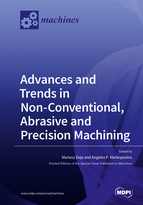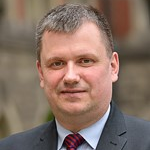Advances and Trends in Non-conventional, Abrasive and Precision Machining
A special issue of Machines (ISSN 2075-1702). This special issue belongs to the section "Advanced Manufacturing".
Deadline for manuscript submissions: closed (15 December 2020) | Viewed by 26758
Special Issue Editors
Interests: adaptive and dynamic process planning; modelling and developing new tools for abrasive processes; design for additive manufacturing DFAM
Special Issues, Collections and Topics in MDPI journals
Interests: manufacturing technology; machining processes; non-conventional machining; modeling and simulation
Special Issues, Collections and Topics in MDPI journals
Special Issue Information
Dear Colleagues,
The modern highly competitive industrial environment demands machining and production processes resulting in exceptional quality and precision. The general trend to design and manufacture more complicated mechanical components, along with the rapidly moving forward material science, raise the need to incorporate and develop new machining techniques in the manufacturing process. Nonconventional machining processes differ from conventional ones, as they utilize alternative types of energy, such as thermal, electrical, and chemical, to form or to remove material. Commonly, the energy source has high power density, while the process features prodigious accuracy, and the capability to produce and handle demanding shapes and geometries. Examples of nonconventional machining processes are electrical discharge machining (EDM), electrochemical machining (ECM), laser processing, and laser-assisted machining. Abrasive processes like grinding, lapping, polishing, and superfinishing are constantly developing and allow for obtaining a fine surface finish along with high efficiency.
There is an increased scientific and commercial interest in in-depth understanding, and further development of the aforementioned nonconventional and precision machining processes. Research is moving forward through experimental studies, as well in the field of modeling and simulation, exploiting the increased available computational power. Multiphysics and multidisciplinary and multiscale modeling are powerful tools in the effort to optimize existing nonconventional precision machining processes, as well to develop novel ones. As their wider use by the industry swiftly grows, research has to be focused on them, not only due to the academic and scientific interest, but also for the possible financial gain.
This Special Issue aims at attracting researchers to present recent advances and technologies in the aforementioned fields, indicating the future trends for nonconventional precision machining processes.
D.Sc., Ph.D. Mech. Eng. Prof. Mariusz DejaProf. Angelos P. Markopoulos
Guest Editors
Manuscript Submission Information
Manuscripts should be submitted online at www.mdpi.com by registering and logging in to this website. Once you are registered, click here to go to the submission form. Manuscripts can be submitted until the deadline. All submissions that pass pre-check are peer-reviewed. Accepted papers will be published continuously in the journal (as soon as accepted) and will be listed together on the special issue website. Research articles, review articles as well as short communications are invited. For planned papers, a title and short abstract (about 100 words) can be sent to the Editorial Office for announcement on this website.
Submitted manuscripts should not have been published previously, nor be under consideration for publication elsewhere (except conference proceedings papers). All manuscripts are thoroughly refereed through a single-blind peer-review process. A guide for authors and other relevant information for submission of manuscripts is available on the Instructions for Authors page. Machines is an international peer-reviewed open access monthly journal published by MDPI.
Please visit the Instructions for Authors page before submitting a manuscript. The Article Processing Charge (APC) for publication in this open access journal is 2400 CHF (Swiss Francs). Submitted papers should be well formatted and use good English. Authors may use MDPI's English editing service prior to publication or during author revisions.
Keywords
- Laser processing/laser-assisted machining
- High-density power machining
- Electrodischarge machining
- Electrochemical machining
- Abrasive processes
- Lapping/polishing/superfinishing
- Ultrasonic machining
- Water jet machining/abrasive water jet machining
- Burnishing
- Other nonconventional machining
- Precision machining
- Micro- and nanomachining
- Machine tools
- Modeling and simulation
- Surface quality and integrity
- Manufacturing systems
- Nanomaterials







